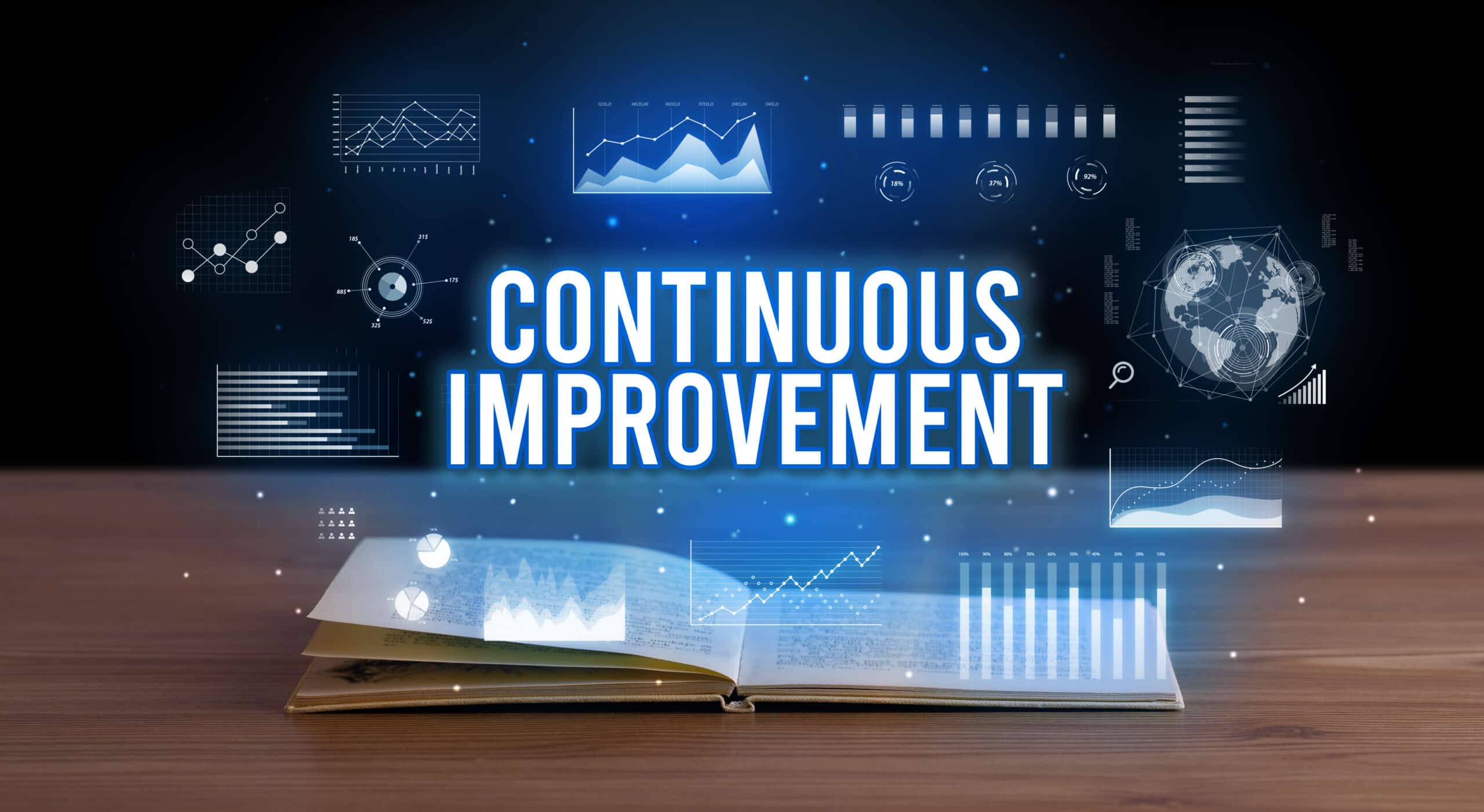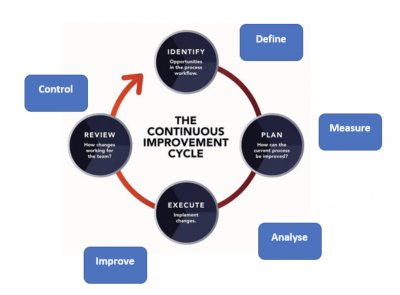
“I don’t have time for this continuous improvement mumbo jumbo, I just need to focus on doing my day job.”
Think again: If we repeat the same mistakes day in and day out, not looking for ways of improving, our competitors will sit up and take our hard-earned customers away. It’s time to really understand the power of continuous improvement.
Overview: What is continuous improvement?
Continuous improvement (CI) is an ongoing effort to improve all elements of an organization, whether this be processes, tools, products, or services. Sometimes the improvements are big, but more often, they are small. However, what’s most important is that they’re frequent, happening all of the time and – hence – continuous.
The term “continuous improvement” can often be used interchangeably with the term “continual improvement,” however, there are some subtle differences to be aware of:
- Continuous: Something that happens all of the time, for example – on a daily basis
- Continual: Something that could happen all of the time
It therefore follows that continuous improvement is always continual, but not vice versa. For reference, use of the word continual is typically found in ISO standards such as the ISO9000 family.
In the context of lean, once again we have another term that can often be used interchangeably with continuous improvement, and this term is Kaizen. The word Kaizen is the combination of two Japanese words: Kai, translating to “change,” and Zen, translating to “good.”
Successful continuous improvement is rooted in three underlying principles:
1. Employee involvement
Employees are your best assets for understanding how work can be completed quicker, with less rework or scrap, and with higher quality.
2. Clearly communicated and carefully scoped goals
These can be cascaded across and down an organization; everyone knows their tasks and responsibilities and are shooting for a common goal.
3. Skills and knowledge share
Use people with suitable skills and experience, coach staff to identify opportunities for improvement, and use tools from Six Sigma and lean methodologies to deliver robust improvement solutions.
Whilst there are many tools and methodologies that can be used in continuous improvement programs, one of the most common is Plan, Do Check, Act (PDCA), often called the Deming Cycle after its founder William Deming.
This never-ending (continuous) circle of improvement is aligned with Six Sigma DMAIC principles, as illustrated in the image below.

Image source: Continuous-improvement cycle
3 benefits of continuous improvement
There are many reasons continuous improvement should be an integral part of your business culture; let’s review three here.
1. It can be successfully deployed across all industries
The concepts, best practices, and tools used in continuous improvement are completely transferable across all sectors, industries, and areas within a company. Highly motivated and engaged people are at the heart of continuous improvement; equipped with the right tools and knowledge, improvements will be discovered and implemented.
2. It engages and empowers employees
The opportunity and responsibility to contribute towards improvement of your workplace, work processes, and product quality can be hugely motivating and satisfying for employees. A positive and like-minded workforce can deliver and importantly sustain continuous improvement programs.
3. It has the potential to transform processes, products, and services
Many small, incremental improvement actions that are diligently implemented can often lead to what is known as transformational change. Here, for example, the process time or product quality undergoes a significant positive change that was only made possible by small, continuous improvement activities.
Why is continuous improvement important to understand?
Embracing continuous improvement delivers real benefits to your organization. Let’s take a look at both how and why.
It maintains and develops a competitive edge
In business, if you stand still and accept the status quo, then you will quickly fall behind your competition. Only by looking for opportunities for continuous improvement can you stay one step ahead of your competition.
It utilizes many lean principles, tools, and methodologies
Potential improvement opportunities are all around us, and we can rapidly identify and implement change with the use of classic lean tools such as 5S, Root Cause Analysis (RCA), and PDCA
It builds and grows employee and customer satisfaction
Successful continuous improvement programs are centered around employee engagement and delivery. Employees have the richest insights into opportunities for improvement, and the great thing is, customers benefit, too, with higher quality and more reliable products and services.
An industry example of continuous improvement
A medical practice received an external audit review that highlighted a number of areas that did not meet required standards. The practice manager, having reviewed the findings, enlisted the services of a Six Sigma Black Belt to help her set up and implement a continuous improvement program.
The Black Belt, having successfully delivered continuous improvement programs in other organizations, decided on a three-stage approach, which included:
- Stage 1: Interviews with staff to understand their job roles and responsibilities plus their knowledge of, and appetite to engage with, continuous improvement activities.
- Stage 2: Assigning continuous improvement leaders and providing them training and coaching on tools and methodologies to use.
- Stage 3: Using visual management techniques, providing a continuous improvement dashboard for all staff to view and contribute to, which was located in the practice staffroom.
An initial three-month trial period was completed, delivering a number of small improvements that built employee trust, understanding, and the desire to contribute more improvement actions.
After a further three-month period, the areas from the audit that had not met required standards underwent significant improvement, and upon re-audit, these were deemed compliant. The continuous improvement teams and culture were now embedded into the daily working of the medical practice.
3 best practices when thinking about continuous improvement
As with many improvement activities, there are a number of key steps to ensure successful delivery. Let’s explore three of these.
1. Lock in early the commitment and resources you need
One of the most common mistakes with continuous improvement programs is to get people enthused, ask for ideas, and then realize you don’t have the resources to follow up and implement the improvements.
2. Spend time to define roles and responsibilities
Having locked in the right resources, always ensure people know what their roles are and what they are delivering. Lack of role and responsibility clarity leads to missed opportunities and employee frustration.
3. Coach, educate, and train employees
To get the best from any continuous improvement program, you need the right people with the right skills who are fully engaged and performing to the best of their ability. Take time to coach, train, and educate where necessary to help people uncover those nuggets of improvement.
Frequently Asked Questions (FAQ) about continuous improvement
Are continuous and continual improvement the same thing?
Yes and no; let’s explain. Continuous refers to something that happens all of the time; continual refers to something that could happen all of the time.
It follows that continuous improvement is always continual, but the reverse is not necessarily true.
Can I use PDCA in my continuous improvement program?
Yes, absolutely! PDCA is one of the most popular tools for implementing continuous improvement utilizing the never-ending cycle of improvement to build upon achieved results.
How do I start a continuous improvement program?
If you start with a clearly defined and achievable scope – and employees who are engaged and hungry for delivering improvement – then you are well on your way to a successful program.
Let’s recap on continuous improvement
Being satisfied with “business as usual” means that over time, your products and services will become less competitive. Embracing and embedding continuous improvement into your business not only delivers a competitive edge, it also delivers improved satisfaction and loyalty from employees and customers alike.